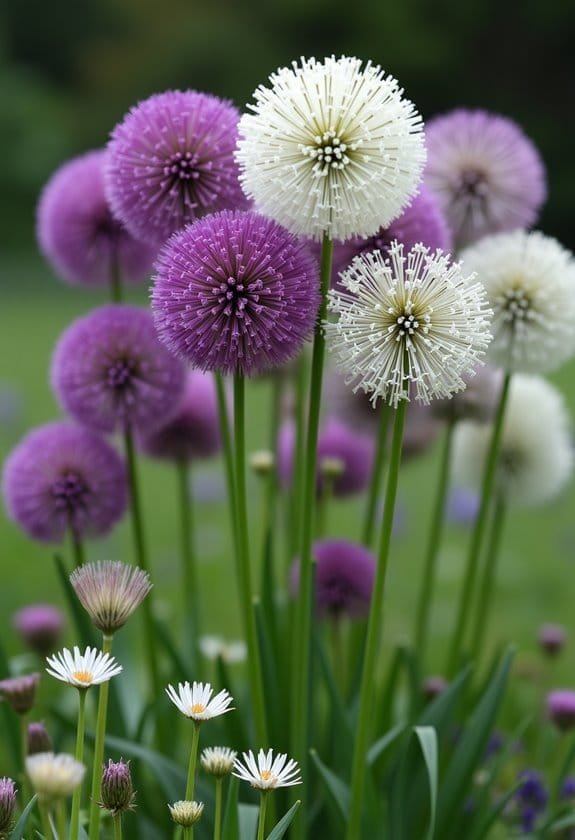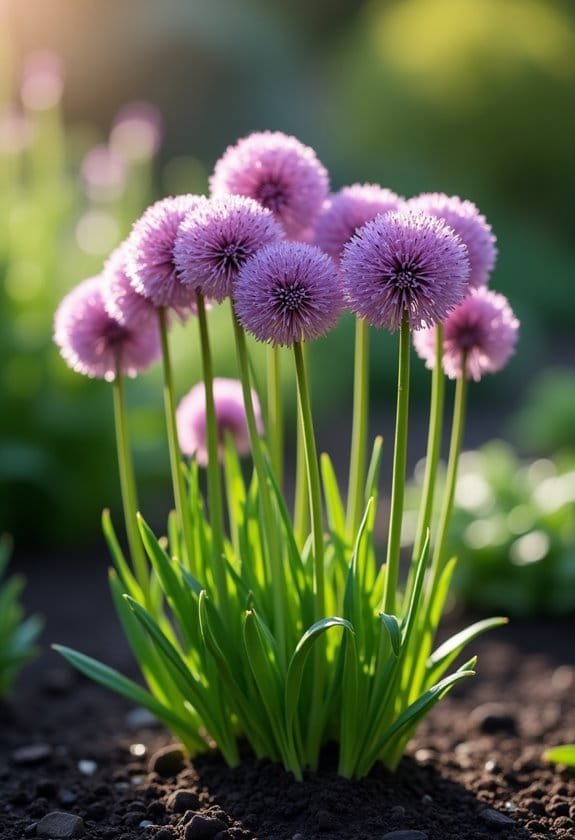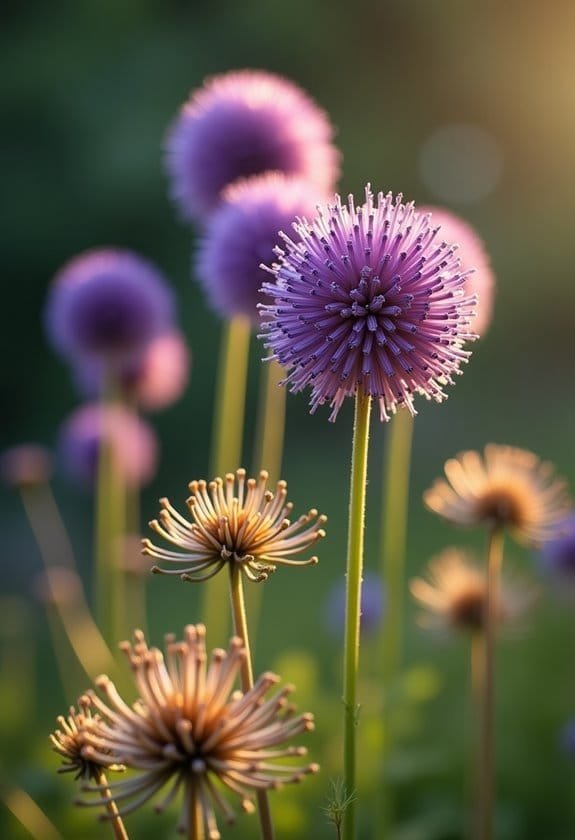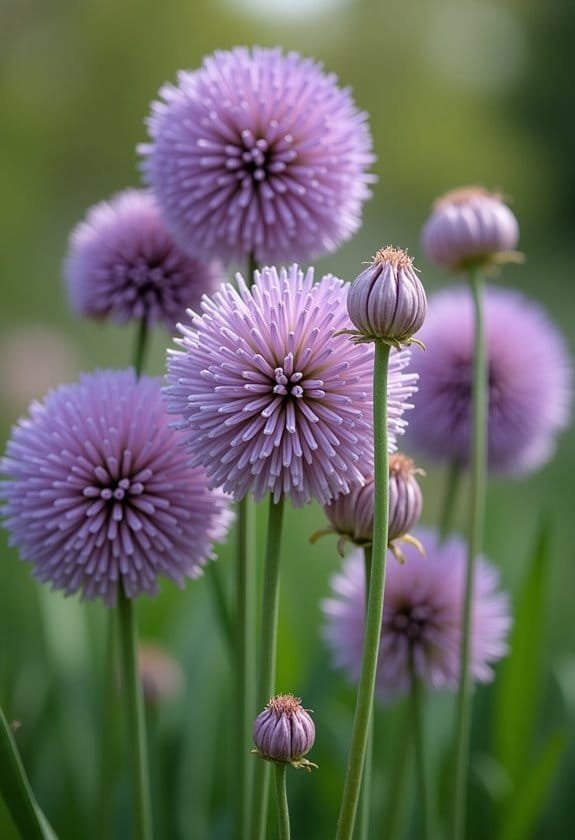Allium species encompass both ornamental and edible plants within the Amaryllidaceae family, featuring 500-750 species worldwide. These versatile plants showcase striking spherical blooms in ornamental varieties like Allium aflatunense, while culinary staples include familiar favorites such as onions (Allium cepa) and garlic (Allium sativum). They thrive in well-drained soils with pH 6.0-7.0 and require 6-8 hours of daily sunlight for ideal growth. The plants' heights range from 6-inch chives to 4-foot ornamentals, offering both visual drama and crucial cooking ingredients. Beyond their aesthetic and culinary appeal, Allium species attract pollinators and provide essential nutrients, making them fascinating subjects for both gardeners and naturalists.
Main Points
- Allium species include both ornamental varieties with spherical blooms and edible staples like onions and garlic from the Amaryllidaceae family.
- Ornamental alliums reach heights from 6 inches to 4 feet, featuring distinctive flower heads that attract pollinators and provide garden interest.
- All alliums require well-drained soil, 6-8 hours of sunlight daily, and proper spacing to prevent disease and ensure optimal growth.
- Edible alliums offer essential nutrients and potential health benefits, while ornamental varieties provide long-lasting visual appeal in gardens.
- Both ornamental and edible alliums bloom from late spring to early summer, with seed heads offering continued decorative value after flowering.
Introduction

Allium species, belonging to the family Amaryllidaceae, represent a diverse genus encompassing both ornamental flowering plants and essential culinary staples like onions and garlic.
The genus's common name "ornamental onion" reflects its close relationship to everyday kitchen varieties, while its scientific designation Allium derives from the Latin word for garlic.
With 500 to 750 distinct species worldwide, these versatile plants have earned their place in both ornamental gardens and vegetable plots, offering striking spherical blooms and vital cooking ingredients that have sustained human civilizations for millennia.
Common Name
Members of the Allium genus are commonly known as ornamental and edible flowering plants that include familiar varieties like garlic, onions, and chives. These versatile plants have earned various common names across different cultures and regions, with ornamental alliums often referred to as ornamental onions in gardening circles.
The descriptive common names frequently reflect the plants' distinctive characteristics, such as the Purple Sensation allium, which showcases dramatic violet-purple blooms atop tall stems.
While culinary alliums maintain straightforward names tied to their kitchen uses, ornamental varieties often carry more poetic monikers that capture their architectural qualities and visual impact in the garden landscape. Among the 500 to 750 species, common names range from the practical "flowering onion" to more specific cultivar designations like "Star of Persia" for A. christophii or "Tumbleweed Onion" for A. schubertii.
These accessible names help gardeners and cooks distinguish between the numerous varieties while highlighting each plant's unique attributes, whether they're destined for the kitchen garden or ornamental borders.
Scientific Name
The scientific classification of these versatile plants falls under the genus Allium, which belongs to the family Amaryllidaceae. This extensive genus encompasses between 500 and 750 distinct species, representing a remarkable diversity of both ornamental and culinary plants that have adapted to various growing conditions.
Notable species include Allium cepa, the common onion, which thrives in well-drained soil and produces characteristic bulb structures that serve as both food storage and reproductive organs.
Allium sativum, commonly known as garlic, demonstrates the genus's agricultural significance, while ornamental varieties like Allium aflatunense showcase its decorative potential through spectacular spherical flower heads.
The North American native, Allium cernuum, exemplifies the dual-purpose nature of many species, offering both aesthetic and culinary value.
These plants share fundamental botanical characteristics while expressing unique adaptations, including varying flower formations, bulb structures, and growth patterns.
Their scientific nomenclature reflects evolutionary relationships and morphological features, providing researchers and gardeners with a standardized system for identification and classification within this diverse plant group.
Overview
Spanning both ornamental and culinary varieties, the vast Allium genus represents one of horticulture's most diverse and valuable plant groups. With an impressive roster of 500 to 750 species, these remarkable plants range from towering ornamental varieties reaching several feet tall to compact culinary staples that grace our gardens and kitchens.
The genus encompasses celebrated ornamental specimens, such as the striking Purple Sensation, which delivers dramatic spherical blooms that serve as natural magnets for essential pollinators. Meanwhile, the culinary members of the family, including garlic, onions, and chives, have established themselves as fundamental ingredients in global cuisine while offering substantial health benefits through their rich vitamin content.
These versatile plants demonstrate remarkable adaptability, thriving in well-drained soils and varying light conditions from full sun to partial shade. Their cultivation follows a predictable rhythm, with bulb planting typically occurring during spring or fall seasons, making them reliable additions to both ornamental landscapes and kitchen gardens.
This adaptability, combined with their dual aesthetic and practical applications, has secured the Allium genus's position as a cornerstone of modern horticulture.
Key Features
Allium species exhibit remarkable diversity in their growth patterns, ranging from compact 6-inch chives to towering 4-foot ornamental varieties that command attention in garden landscapes.
The plants showcase distinctive spherical flower heads composed of numerous small, star-shaped blooms arranged in perfect symmetry, with colors spanning from classic purple and white to uncommon yellow and pink varieties.
These hardy perennials typically flower from late spring through early summer, though specific blooming periods vary by species and climate zone, creating extended seasonal interest in gardens and natural settings.
Growth Size
From delicate wild specimens to towering ornamentals, members of the Allium family showcase remarkable diversity in their growth sizes. The height variations among ornamental varieties typically span from 1 to 3 feet, offering gardeners flexibility in their landscape designs and planting schemes.
Throughout their growth stages, alliums demonstrate distinctive characteristics that influence their final dimensions. Wild garlic, for instance, develops into dense carpets of foliage during early spring, while ornamental varieties maintain more structured, upright forms.
When making size comparisons between species, it's worth noting that edible alliums typically produce more modest growth patterns, characterized by their slender grey-green leaves.
Some varieties, such as Allium schubertii, create particularly dramatic displays with their spidery flower formations, which can extend notably beyond the plant's base diameter. The flower heads themselves follow a consistent structural pattern across species, featuring six petal-like sepals arranged in two rows, though the overall size of these blooms varies considerably among different cultivars.
This architectural diversity enables gardeners to create layered plantings that maximize visual impact throughout the growing season.
Appearance
The distinctive appearance of Allium species sets them apart in any garden setting. Their slender, grey-green leaves exhibit a characteristic pungent fragrance when damaged, contributing to the plant's unmistakable identity. These striking plants showcase remarkable leaf characteristics that complement their architectural form in the landscape.
The most enchanting feature of Alliums lies in their spectacular flower heads, which emerge as perfect spheres composed of countless tiny, star-shaped blooms. These floral displays create dramatic visual impact through their diverse color palette, ranging from deep purples and vibrant blues to delicate pinks, pristine whites, and sunny yellows.
Height variations among different species, typically spanning from one to three feet, allow gardeners to create layered displays that maximize visual interest throughout the growing season. The nodding onion demonstrates particularly unique aesthetic qualities with its gracefully drooping flower clusters, while edible varieties like chives contribute both ornamental and culinary value through their attractive blooms.
These versatile plants maintain their sculptural presence even as seed heads, extending their decorative appeal well beyond the flowering period.
Flowering Season
Spectacular blooms emerge during alliums' peak flowering season, which typically spans from late spring through early summer.
Ornamental varieties like Allium giganteum and 'Purple Sensation' produce striking globe-shaped flower clusters that transform gardens into living sculptures, attracting beneficial pollinators throughout their flowering duration.
The blooming colors and timing create a harmonious progression across the growing season, with early-flowering species like Allium moly heralding the arrival of spring.
As temperatures rise, mid-season varieties take center stage, followed by culinary alliums such as garlic and chives that extend the seasonal appeal into late summer.
This successive flowering pattern guarantees continuous garden interest and provides essential resources for beneficial insects.
The extended blooming sequence of allium species makes them invaluable components in perennial garden designs, where their architectural forms complement surrounding plantings.
Their flowering duration bridges vital gaps between spring bulbs and summer perennials, maintaining visual interest through strategic placement of early, mid, and late-season varieties throughout the landscape.
Growing Requirements

Successful cultivation of allium species hinges on providing ideal growing conditions that mirror their natural habitat preferences.
Most alliums flourish in well-draining soil with a pH between 6.0 and 7.0, requiring consistent moisture levels while avoiding waterlogged conditions that can trigger destructive fungal diseases.
These resilient plants demonstrate remarkable adaptability to various light conditions, though they perform best with 6-8 hours of direct sunlight daily and can tolerate temperature fluctuations between 35°F and 75°F during their active growing season.
Light
Most Allium species flourish in full sun conditions, demanding at least 6 hours of direct sunlight daily for ideal development.
These versatile plants exhibit distinct light preferences that greatly influence their growth patterns and overall liveliness in garden settings.
For edible varieties like garlic and onions, favorable light conditions play an essential role in both plant health and flavor development.
Well-illuminated locations promote robust root systems while minimizing the risk of fungal diseases that often plague plants in shadier, damper environments.
The light impact on ornamental alliums is equally considerable, as these showstopping flowers rely on abundant sunlight to produce their magnificent spherical blooms.
When grown in inadequate light conditions, alliums often struggle to reach their full potential.
Shade-grown specimens frequently display elongated stems, reduced flower size, and diminished aromatic properties.
While some varieties can tolerate partial shade, their performance significantly declines with reduced sun exposure.
Gardeners should carefully consider light availability when planning allium placement, as proper positioning in sun-drenched areas will reward them with robust growth and spectacular flowering displays.
Soil
Beyond sunlight requirements, the foundation of healthy allium growth lies in proper soil conditions. For ideal development, alliums need well-drained, fertile soil types that protect their bulbs from potentially devastating fungal infections and rot issues. The soil's structure should facilitate consistent moisture movement while retaining essential nutrients for sustained growth.
Effective drainage techniques play an essential role in allium cultivation, as these plants can't tolerate waterlogged conditions that often lead to root diseases. Gardeners should incorporate organic matter or coarse sand to improve drainage, while raised beds offer an excellent solution for areas with naturally heavy soils.
Nutrient management begins with maintaining the correct pH balance between 6.0 and 7.0, which guarantees proper nutrient uptake and robust plant development. This ideal range allows alliums to access critical minerals and nutrients efficiently, supporting both vegetative growth and flowering potential.
When preparing planting sites, it's beneficial to integrate slow-release fertilizers or well-rotted compost to establish a strong nutritional foundation, remembering that excessive fertility can lead to lush foliage at the expense of bulb development.
Water
Proper water management stands at the heart of thriving allium cultivation, where maintaining consistent moisture without oversaturation proves essential. Successful watering techniques balance the plant's need for hydration while respecting its vulnerability to excess moisture, which can lead to devastating bulb rot and fungal complications.
These resilient plants demand strategic moisture control, particularly in regions with high humidity levels where disease susceptibility increases considerably. Deep watering during dry spells encourages robust root development, while allowing the soil to partially dry between applications helps prevent waterlogged conditions that can compromise plant health.
The relationship between drainage needs and water management becomes especially critical during the growing season, when alliums require reliable moisture without standing water.
While most allium varieties demonstrate remarkable drought tolerance once established, they benefit from consistent irrigation during their active growth and flowering phases. In humid environments, gardeners should focus on maintaining adequate air circulation and monitoring soil moisture levels carefully, adjusting watering schedules to accommodate natural rainfall patterns and seasonal variations in temperature and humidity.
Temperature
Temperature plays a pivotal role in the success of allium cultivation, with most species flourishing in moderate conditions between 60°F and 75°F (15°C to 24°C). This ideal range supports robust growth and abundant flowering, reflecting these plants' remarkable climate adaptation capabilities.
These versatile plants demonstrate distinct responses to seasonal variations, particularly requiring a cold dormancy period that makes them well-suited to regions with defined winters. Like clockwork in nature's calendar, this chilling phase triggers essential biological processes for proper bulb development and subsequent flowering.
However, temperature extremes, especially those exceeding 85°F (29°C), can greatly impact plant health and performance. In warmer climates, alliums may exhibit stress symptoms, including reduced flowering and compromised bulb formation.
For edible varieties such as garlic and onions, temperature management becomes especially critical during bulb development. Fall planting takes advantage of natural cooling cycles, allowing bulbs to establish strong root systems before winter dormancy.
Gardeners in warmer regions must often employ additional strategies, such as mulching and adequate irrigation, to moderate soil temperatures and maintain ideal growing conditions.
Pollinator Criteria
Allium species serve as powerful magnets for pollinators, with their distinctive spherical flower heads offering convenient landing platforms for bees and butterflies.
Their extended blooming periods, particularly in ornamental varieties like Purple Sensation and Giant Allium, create crucial bridges between spring and summer flowering seasons, ensuring continuous nectar sources for beneficial insects.
These remarkable plants contribute considerably to garden biodiversity, as their nectar-rich blooms attract essential pollinators while remaining naturally resistant to browsing wildlife, making them ideal components of pollinator-friendly landscapes.
Attracted Pollinators
Buzzing bees and fluttering butterflies find themselves irresistibly drawn to the vibrant, spherical blooms of allium species. These remarkable flowers, with their distinctive six-petaled structure arranged in symmetrical rows, serve as perfect landing platforms for diverse pollinators seeking sustenance.
The clustered arrangement of allium blooms creates an efficient feeding station, enhancing pollinator diversity throughout the garden ecosystem.
Strategic garden design incorporating various allium species can establish reliable nectar sources across the growing season. From early-blooming ornamental varieties to late-season edibles like chives and garlic, these plants create a continuous buffet for beneficial insects.
The impressive spherical flower heads, which can range from two to eight inches in diameter, act as natural beacons for passing pollinators. When gardeners plant alliums in concentrated groups, they're not just creating visually striking displays but also establishing powerful pollinator magnets in their landscape.
This clustering approach proves particularly effective in supporting local pollinator populations, as it minimizes the energy expenditure required for insects to move between blooms while maximizing their foraging efficiency.
Pollination Method
The process of successful pollination in allium species depends heavily on specific characteristics that attract the right pollinators. The distinctive spherical flower clusters, composed of numerous small blooms, create an optimal platform for pollen transfer between visiting insects and the plant's reproductive structures.
The floral morphology of alliums plays a vital role in facilitating effective pollinator behavior, as their open-faced flowers provide easy access to nectar and pollen. Bees and butterflies, the primary pollinators of these plants, can efficiently navigate the densely packed flower heads while moving from one tiny bloom to another.
Their synchronized blooming period aligns perfectly with peak pollinator activity seasons, enhancing reproductive success.
The pollination mechanism benefits from alliums' natural defense against herbivores, as deer and rabbit resistance guarantees uninterrupted access for beneficial insects.
This ecological adaptation has resulted in a highly efficient pollination system where the structural arrangement of flowers, combined with their attractive qualities, creates an ideal environment for consistent pollen transfer, contributing considerably to the species' reproductive success and genetic diversity.
Care & Maintenance

Successful allium cultivation begins with proper planting in well-drained soil and full sun exposure, ensuring bulbs are positioned at the correct depth to prevent rot and promote vigorous growth.
Regular maintenance includes monitoring for common pests like aphids, removing spent flowers promptly, and providing consistent moisture without overwatering during the growing season.
Gardeners can enhance their allium displays by strategically placing these statuesque flowers among complementary perennials such as salvias and ornamental grasses, which help conceal the alliums' naturally yellowing foliage after blooming.
Planting Tips
Growing alliums successfully requires careful attention to planting conditions and ongoing care. Ideal planting techniques involve selecting well-drained locations that receive full to partial sunlight, which guarantees robust root development and vibrant blooming cycles.
Gardeners should consider seasonal planting windows, with spring and fall being perfect times to establish new bulbs.
Creating stunning cluster arrangements, rather than isolated plantings, maximizes the visual impact of these striking ornamentals while promoting better overall garden health.
When planning edible varieties like garlic and chives, it's crucial to maintain proper spacing and soil conditions to prevent waterlogging and subsequent bulb deterioration. The integration of organic matter into the planting medium enhances drainage capabilities and nutrient availability.
Successful establishment depends on planting depth, which varies by species but typically requires positioning bulbs at two to three times their diameter below soil level.
After flowering, maintaining garden vitality involves strategic division of bulb offsets and precise foliage management. This approach not only preserves the plants' vigor but also guarantees sustained growth and proliferation throughout subsequent growing seasons.
Ongoing Care
Maintaining allium's vibrant growth requires vigilant attention to several key care practices throughout the growing season. Regular monitoring for common pests, particularly aphids and onion flies, guarantees these striking ornamentals remain healthy and vigorous. Various allium varieties benefit from consistent pest management strategies, including prompt removal of affected foliage and appropriate cultural controls.
Seasonal care plays an important role in sustaining these garden favorites. After the spectacular flowering display concludes, it's necessary to cut back the deteriorating foliage, which allows the plant to direct energy toward strengthening its bulbs for future growth.
Well-drained soil conditions are paramount for all allium species, as excessive moisture can lead to devastating bulb rot and mildew issues. For less hardy allium varieties, winter protection becomes critical through careful bulb storage in cool, dry environments.
When spring arrives, gardeners should focus on dividing and replanting bulb offsets, a practice that not only maintains plant vigor but also expands their collection. This regenerative approach guarantees continuous displays of these architectural beauties while promoting robust growth throughout successive seasons.
Suggested Companions
The art of companion planting with alliums enhances both garden aesthetics and plant health through strategic combinations. When selecting companion plants, gardeners can create visually striking displays by pairing ornamental alliums with low-maintenance perennials such as coneflowers and sedums, which complement their architectural forms and extended blooming periods.
Planting strategies that incorporate edible alliums like garlic and chives alongside other herbs maximize the biodiversity benefits within vegetable gardens. These aromatic companions not only contribute to the garden's productivity but also serve as natural pest deterrents, as their pungent properties help protect neighboring plants from unwanted visitors like deer and rabbits.
For ideal results, gardeners should plant alliums in clustered arrangements rather than isolated positions, which amplifies their visual impact and attracts beneficial pollinators to the garden ecosystem.
These groupings work particularly well when surrounded by plants that share similar cultural requirements, such as well-draining soil conditions and full sun exposure. This thoughtful arrangement guarantees that both alliums and their companion plants thrive together, creating a harmonious and sustainable garden environment.
Common Issues
Allium species face several significant challenges from both pests and diseases that can compromise their health and vigor.
Common invertebrate threats include aphids and onion flies, while fungal issues such as bulb rot and white rot tend to emerge in poorly-drained soils.
Effective management combines vigilant monitoring, proper cultural practices like adequate spacing and drainage, and intervention with appropriate treatments when necessary to maintain healthy plants.
Pests/Diseases
While these hardy plants offer many benefits to gardeners, allium species face several significant pest and disease challenges that can impact their health and productivity.
Disease prevention strategies must focus particularly on managing moisture levels, as excessive dampness creates ideal conditions for destructive fungal infections like white rot and rust.
Implementing effective pest management techniques becomes essential when dealing with common invaders such as aphids and onion flies, which can devastate both foliage and bulbs if left unchecked.
Gardeners must regularly inspect their plants for early signs of infestation, ensuring prompt intervention before these pests establish large colonies.
The development of fungal resistance traits in some allium varieties has helped combat certain diseases, though proper cultural practices remain vital for maintaining plant health.
Proper soil drainage serves as the cornerstone of disease prevention, while strategic spacing between plants promotes adequate air circulation.
When symptoms of white rot appear, characterized by yellowing leaves and rotting bulbs, immediate action is necessary to prevent its spread throughout the garden, as this persistent fungal pathogen can remain viable in soil for many years.
Solutions
For successful allium cultivation, gardeners can implement several proven solutions to address common growth issues. Strategic fertilizer options, including balanced NPK formulations and organic amendments, help strengthen plants against fungal infections while promoting robust root development.
Implementing proper pruning techniques plays an essential role in maintaining plant health, as removing spent flowers and yellowing foliage prevents energy drain and reduces disease susceptibility.
Companion planting with drought-tolerant species like yarrow and sage helps create ideal growing conditions by improving soil structure and deterring harmful pests naturally.
To combat dampness-related problems, establishing raised beds or incorporating coarse sand into heavy soils greatly improves drainage.
During winter months, protecting non-hardy varieties requires careful lifting and storage in cool, dry locations, with bulbs wrapped in newspaper or stored in mesh bags.
Regular inspection for pest infestations, particularly during spring growth periods, allows for early intervention through targeted organic pesticides or beneficial insect introduction.
Maintaining adequate spacing between plants guarantees proper air circulation, which considerably reduces the likelihood of mildew development and promotes vigorous growth throughout the growing season.
Summary

Nature's garden gems, the diverse Allium family boasts between 500 and 750 species that serve both ornamental and culinary purposes. From the striking Purple Sensation to everyday kitchen staples like garlic and onions, these versatile plants offer a remarkable range of applications for both gardeners and culinary enthusiasts.
The family's culinary uses extend well beyond basic seasonings, with varieties like chives and leeks providing essential nutrients including vitamins A, C, and K, while potentially offering anticancer properties.
For gardening tips, experts recommend placing alliums in well-drained, sunny locations, where they'll thrive with minimal maintenance requirements. These hardy plants reward gardeners with stunning displays in shades of blue, purple, and white, creating visual interest throughout the growing season.
The ecological benefits of alliums can't be overstated, as their distinctive blooms attract crucial pollinators such as bees and butterflies, fostering biodiversity within garden ecosystems.
Whether cultivated for their ornamental appeal or their flavorful contributions to cuisine, alliums stand as proof of nature's ability to combine beauty with practicality in a single botanical family.


